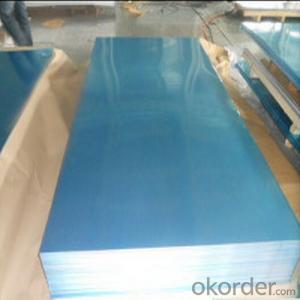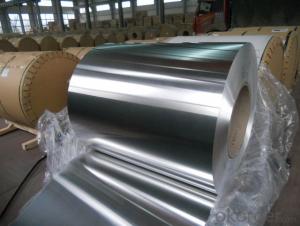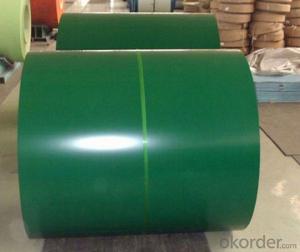High Quality Camo Aluminum Sheets with Plastic Film Coated
- Loading Port:
- Shanghai
- Payment Terms:
- TT OR LC
- Min Order Qty:
- 5 m.t.
- Supply Capability:
- 10000 m.t./month
OKorder Service Pledge
OKorder Financial Service
You Might Also Like
Specification
1.Structure of Plastic Film Coated Aluminum Sheet Description:
Plastic Film Coated Aluminum Sheets are widely used for building use, decoration use, making cookware, busing making, shipping building, airplane making and so on。Sizes of aluminum sheet for decoration use: Thickness: 0.3mm~300mm Width: Under 2000mm ( Standard: 1000mm, 1219mm, 1500mm, 1540mm) Length: Under 10000mm. Products commonly used in signs, billboards, building exterior decoration, bus body, high factory wall decoration, kitchen sink, lamp, fan, electronic components, chemical apparatus, sheet processing, deep drawing or spinning hollow ware, welding parts, heat exchangers, Bell surface and plate, plates, kitchen utensils, accessories, safety equipment and other.
2.Main Features of Plastic Film Coated Aluminum Sheet:
Reasonable and stable chemical composition
Accurate tolerance
Nice mechanical property
Standards: EN, ASTM and JIS
3. Plastic Film Coated Aluminum Sheet Images:



4. Plastic Film Coated Aluminum Sheet Specification:
| Aluminium sheet | |||||
| Alloy No. | Thickness (mm) | Width (mm) | Length (mm) | Temper | |
| A1050,A1060, A1070,A1100 | 0.2-100 | 20-2200 | 20-8000 | O,H12,H22,H14,H16,H18, H24,H26,etc | |
| 3A21,A3003,A3105,A3004 | 0.2-100 | 20-2200 | 20-8000 | O,H14,H18,H24,etc | |
| A5052 ,A5005,A5083,A5754 | 0.2-100 | 20-2200 | 20-8000 | O,H18,H24,H32,H34,H111,H112 ,etc | |
| A6061,A6082,A6063 | 0.2-200 | 20-2200 | 20-8000 | T4,T6, T651,etc | |
| A8011 | 0.2-100 | 20-2200 | 20-8000 | O,H12,H22,H14,H16,H18,H24,H26, etc | |
5.FAQ
1.Q: What about leadtime ?
A: Normally the leadtime is 60days after we receive the deposit and confirm the details. All the press machines we use is the best quality in China Yangli brand. The press machine leadtime from Yangli is 50days, the best leadtime we can give is 60days.
2.Q: What's the lead time for moulds?
A: Normally the mould leadtime is 45 days after we confirm all the details with customer. Our professional mechanical enginners from Austria will design the mould according to the samples from customer, or by the specifications offered by customers.
3.Q:What kinds of mould you can make? and what is your strong point for the moulds?
A: we can make wrinkle wall mould and smooth wall mould both. For wrinkle wall mould we can make, 79" pan, fish pan, bbq pan. For smooth wall mould we can make muffin cup, and cake cup, tar cup,etc. We can also make 2 or 3 portion conatiner moulds as long as you offer us sample or specifications. Our strong points are all our moulds are WEDMLS cut, which makes the mould more accurate and precise. Important materials likestainless steel parts we make in Austria. We also recut after heat treatment, which most of makers do not take this process..
- Q: What is the difference between aluminium plate 5A05 and 5A06?
- The aluminum plate doesn't have this material. Have you made a mistake?Give you a full one,1, pure aluminum: Material: 1050/1060/1070/1100/ 1200/ thickness: 0.1---20mm width: 800---2200mm2, alloy aluminum: Material: 2A21/3003/5052/5083/6061/6082 /8011 thickness: 0.5---260mm width: 800---2800mm3 curtain wall Kaiping aluminum plate: Material: 1060/1100 thickness 0.95, 1.35, 1.85, 2.35, 2.7, 2.85mm, width 0.8---1.5m
- Q: Can aluminum sheets be used for bus bodies?
- Indeed, bus bodies can be constructed using aluminum sheets. Aluminum, renowned for its lightweight and durable qualities, is frequently utilized in the fabrication of bus bodies. Its exceptional strength-to-weight ratio renders it an optimal selection for bus manufacturers, as it enhances fuel efficiency and expands payload capacity. Moreover, aluminum exhibits remarkable resistance to corrosion, a valuable attribute for vehicles perpetually confronted with diverse weather conditions. Additionally, aluminum can be effortlessly shaped and fabricated, enabling the production of intricate forms and designs. Consequently, aluminum sheets are widely favored for bus bodies owing to their robustness, lightness, resistance to corrosion, and adaptability.
- Q: can the oxide film on the surface of aluminum sheet prevent the erosion of acid liquid? Why?
- yes, acid can react with aluminum oxide , generating salt and water, but its anti-corrosion will be stronger if oxide film on the surface is enough dense.
- Q: So my new farrier comes out tomorrow and charges $20 more for aluminum shoes and I was wondering why that is? Is one better than the other? My horse is a TB hunter jumper. Tell me what you think :)
- According to my farrier, aluminum shoes are harder to put on because they are softer than steel and they are easier to damage while shaping them for your horse's foot. He also says that aluminum shoes wear down faster than steel shoes, so if you are working a horse in a highly competitive sport, it's better to put steel shoes on. Most racehorses have aluminum shoes put on simply because they're lighter, but if you don't want to be changing the shoes every two weeks, or can't afford to, then steel shoes are the best way to go.
- Q: Is it possible to utilize aluminum sheets in interior design projects?
- <p>Yes, aluminum sheets can be used for interior design purposes. They are lightweight, durable, and resistant to corrosion, making them suitable for various applications such as wall cladding, ceilings, and furniture. Aluminum sheets can also be painted or anodized to achieve different finishes, adding aesthetic appeal to your design. However, it's important to consider the specific requirements of your project, such as load-bearing capacity and thermal insulation, as these properties can vary with different types of aluminum sheets.</p>
- Q: How do aluminum sheets perform in terms of wear resistance?
- Due to their inherent properties and surface characteristics, aluminum sheets generally exhibit good wear resistance. They are lightweight yet durable, boasting a high strength-to-weight ratio, which makes them suitable for various applications that require wear resistance. To further enhance the wear resistance of aluminum sheets, various methods can be employed. Alloying, heat treatment, and surface treatments are among the techniques that can be utilized. By incorporating elements like copper, magnesium, or zinc into aluminum, its hardness and wear resistance can be improved. Heat treatment processes such as precipitation hardening can also bolster the strength and wear resistance of aluminum sheets. Moreover, the wear resistance of aluminum sheets can be significantly enhanced through surface treatments such as anodizing or the application of protective coatings. Anodizing forms a protective oxide layer on the surface of aluminum, providing increased resistance to abrasion, corrosion, and wear. Coatings like powder coatings or paint can also serve as an additional layer of protection against wear and tear. In various industries such as automotive, aerospace, construction, and marine, aluminum sheets find widespread use due to their excellent wear resistance. They are commonly employed in components that undergo sliding, rubbing, or impact, such as panels, body parts, and structural elements. While aluminum sheets may not possess the same level of wear resistance as certain steel alloys or other specialized materials, they offer a favorable balance between strength, weight, and wear resistance. Through appropriate alloying, heat treatment, and surface treatments, aluminum sheets can provide satisfactory wear resistance across a wide range of applications.
- Q: This question asks about the various color options available for aluminum sheets.
- <p>Aluminum sheets are available in a wide range of colors to suit various applications and aesthetic preferences. Common colors include silver (anodized), white, black, and clear (natural). Beyond these, there are also options for colors like red, blue, green, and yellow. Some manufacturers offer custom color matching services for specific projects. Additionally, aluminum sheets can be coated with various finishes such as matte, gloss, or textured, further expanding the color and appearance options. It's important to check with specific suppliers for their available color range as it can vary.</p>
- Q: Can aluminum sheets be formed into seamless tubes or pipes?
- Seamless tubes or pipes can indeed be created from aluminum sheets. This is commonly achieved by employing a technique known as extrusion, in which the aluminum sheet is heated and compelled through a die to acquire the desired form. The extrusion process enables the production of seamless tubes or pipes that possess uniform dimensions and a polished surface. Due to its exceptional versatility and malleability, aluminum is an ideal material for numerous applications necessitating lightweight and corrosion-resistant tubing.
- Q: Can aluminum sheets be used in construction?
- Construction can indeed utilize aluminum sheets. Aluminum, a versatile and lightweight material, possesses numerous advantageous properties for construction purposes. Its corrosion resistance allows for both indoor and outdoor applications. Moreover, aluminum sheets exhibit a high strength-to-weight ratio, granting them durability and strength while remaining relatively lightweight. This characteristic proves advantageous in construction projects where weight is a consideration. Furthermore, aluminum is non-toxic and highly recyclable, making it an environmentally conscious option. When combined with its aesthetic appeal and ease of fabrication, aluminum sheets become a favored choice for a variety of construction applications such as roofing, cladding, wall panels, window frames, and more.
- Q: What rules or guidelines exist for using recycled aluminum sheets in construction projects?
- <p>Yes, there are regulations and guidelines regarding the use of recycled aluminum sheets in construction. These often include standards for material quality, safety, and environmental impact. The American Society for Testing and Materials (ASTM) and the Aluminum Association provide specifications for recycled aluminum alloys used in construction. Compliance with building codes and local regulations is essential. Additionally, recycled aluminum must meet performance and safety standards equivalent to those of new materials. It's crucial to check with local building authorities and consult the latest industry standards to ensure compliance when using recycled aluminum in construction.</p>
Send your message to us
High Quality Camo Aluminum Sheets with Plastic Film Coated
- Loading Port:
- Shanghai
- Payment Terms:
- TT OR LC
- Min Order Qty:
- 5 m.t.
- Supply Capability:
- 10000 m.t./month
OKorder Service Pledge
OKorder Financial Service
Similar products
Hot products
Hot Searches
Related keywords




























